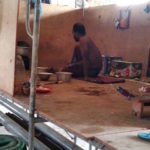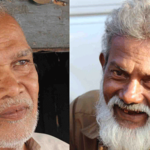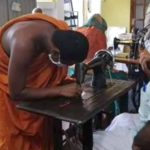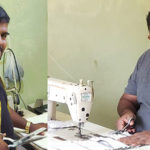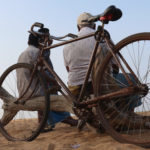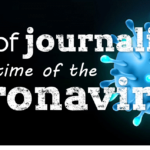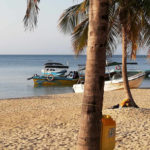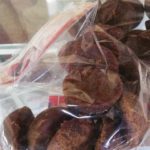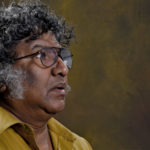In Conversation with Chandraguptha Thenuwara
“We destroyed their memorials and earned hatred.”
Prof. Chandraguptha Thenuwara is one of the main protagonists in Sri Lanka’s field of visual art. His art and social activism create strong political narrations and can be considered representing a cross section of the Sri Lankan polity. He invites Sri Lankan society to re-read the tragedy of 1983 Black July, 35 years after that incident.
Prof. Chandraguptha Thenuwara is one of the main protagonists in Sri Lanka’s field of visual arts.His art and social activism create strong political narrations and can be considered as representing a cross section of Sri Lankan polity.He invites Lankan society to re-read the tragedy of 1983 Black July, 35 years after the incident.
—–
As an artist and a social activist, why are you so artistically focused on Black July?
In 1983, I was a 23-year-old youth living in Colombo doing a short-term job after finishing my university education. Black July happened before our eyes. We could not do anything to prevent it. As a person who witnessed this evil, my response was later expressed in art form for the first time in 1993, while I was abroad for my higher education when narrations about the disaster echoed in my mind. The 1988-89 period of chaos was also a dark memory, but 1983 Black July was overwhelming. Later I developed ‘Barrelism’ which opened a new path in art as a medium of expression. Since then, at least once a year, I have been performing my duty with regard to it as an artist.
Some memories cannot be celebrated. But I have found the opportunity to speak up about them. That cannot be done by painting dead men and blood. The true problems beneath the incidents must be highlighted. During the war, my stand was that this necessitated a military solution. Therefore, I was labeled an enthusiast of Tamil nationalism. In a time where Buddhist monks were spreading war mentality, I opted to spread true Buddhism through my Dhammapada exhibition. I selected timely political themes and tried to give society the chance to discuss the ill-effects of extremism and ethnic violence.
There is criticism that some social tragedies are better forgotten instead of opening them up for discussions. How do you take forward your project before such a context?
Some memories must be saved in the mind, even if they are bitter, because such a memory is important to ensure they don’t recur. Civilization is not based only on good memories. Even some disastrous events have contributed to our progress. For example, even memories about World War II can be utilized to prevent suppression of an ethnic community. Civilization moves ahead with memories preserved with such purpose. They comprise of both good and bad effects. We can point out to a bad memory and demand that we avoid their recurrence. . Likewise, we can highlight good memories and wish them to recur.
The artist must not be manipulatedIn Sri Lanka, certain memories have become a part of political agendas, dwindling after political mileage is achieved. Ahinsakayange Aramaya or the Temple of Innocent People is a good example of this . It had a tragic end.
Such a fate will not be the result, if the urge for remembering emerges from the intrinsic drive of an artist or a citizen. Otherwise, it becomes a mere remembrance targeted to build power. In terms of Ahinsakayange Aramaya, I have criticism against the artist too. As far as I know, Mrs. Chandrika suggested installing that memoir in Suriyakanda. It would have remained if it was built there. At least the memory of destruction would remain. As an activist who fought to safeguard the installation, I came to know that it had been removed with the consent of the creator. Governments destroy or remove works of art for political aims. But we must remember the removal of Ahinsakayange Aramaya. When the same person who removed Ahinsakayange Aramaya is promoted as the next leader covering to the people’s welfare, naturally, we are compelled to think that the violator who removed the memorial is coming back. The problem is why people forget. Where is that artist? We now have a problem of whom he speaks about.. That is why artists must not be manipulated by governments.
My creations are based only on my innate impulses and various elements have been harassing me since 2006. An independent artist cannot survive alone in such a context. Therefore, they must be around people. A cash-strapped artist who tries merely to appease the patrons is just a decorator.
We only glorify war heroesThirty five years later, do you think that the social context that paved the way for Black July has changed or ended?
I think it takes a long time to heal such wounds. Even 50 years after the end of World War II, there are still people with a Nazi mindset. Society must be enlightened to prevent this. The role of artists, social activists and even politicians, is to empower society with regard to that. Advanced societies run projects in order to prevent recurrence of such dark incidents. But we are not sure if we have transformed the 2009 war victory into a true triumph. We only talked about glorifying war heroes. We could have used that momentum to sustain peace if we had converted it into a true victory. But we had to drag some politicians to do that like taking dogs that hate water to bathe. They formed the structure for investigating disappearances, hesitantly. They are not ready to hear the people’s the truth. Instead, we destroyed their memorials and earned hatred. We failed to protect them.
We have a past of preserving the memorials of our enemies. King Dutugemunu did so. We ended the story of King Dutugemunu at the place he killed King Elara and we forgot the aftermath of Elara’s death. We forgot to teach society that King Dutugemunu built a memorial to King Elara. We must keep up this discourse to prevent the efforts of politicians who try to capture power unscrupulously.
The provision of economic and social facilities are not sufficient. We must share duties and responsibilities in a political framework. Present society does not exist without political power. Each ethnicity must have powers that can be utilized for their benefit. Mahinda Rajapakse promised powers beyond the 13th amendment but then forgot about it. No one even dares to implement the existing provisions of the constitution. Even the forces that have majority representation refrain from doing what is necessary to do in fear of losing their popularity. We boast about Sri Lankan identity but we have not started the project to build the Sri Lankan nation. Some try to seek political mileage from the context. For example, men wearing saffron robes appearing as Buddhist monks while not following Buddha’s philosophy are like that. People love them. They propagate a religion of war. I discuss this in my art. There are pious monks who appreciate the discussions that happen in art. Such discussions do not happen within institutional Buddhism.
We could prevent disasterWhat aspects of Black July do you touch on in your work this year?
Some are memoirs. One such remembrance is Barrelism. I have created a sign with barbed wire to represent military camps. Networks of military camps that target maintaining power with a political and extremist view still exist in our society. Barbed wires are hidden in society. The sacred lotus is used to depict dirty work. Plots are being hatched underneath them. We need to talk about them.
Post May 21 incidents and especially the incidents on May 13 brings back memories of Black July. We could avoid another major pogrom because the majority has changed and we can find only a few violent extremists. Some politicians have also changed. But the extremists can still ignite racist fires. Those who highlight Dharmapala’s early lectures hide the fact that he had said in his late life that he would not wish to be born again in this island.
One of my sculptures this time is called Sehesi Rakusa or Ferocious Devil and is a form of expressionist art. I discuss the way Buddhist philosophy transformed into Buddhism. Some paintings talk about it. In parallel, an exhibition of selected work of my contemporaries who share similar views is also ready to be held on 23rd July. The event will be declared open at 5 p.m. at the Lionel Wendt Art Gallery. My exhibition opens at Sathya Fernando Art Gallery at the same time and is titled as 13+.
Do we need this extremism?
Perhaps those who tried to create a Black May this year might be the persons who had not been moved by the tragedy of Black July. However, a major disaster was prevented thanks to intelligent people. But our failure as a society was to learn lessons from disasters and tragedies and that is problematic.
I now try to find an answer to that question. Why did I name my exhibition as 13+? Those who initially promised power sharing by moving beyond the 13th amendment to the constitution, have lost power. They now try to regain power through other projects. We have to work in a society where Sinhala Buddhists are the major community. That majority must actually be criticizing the extremism from the minorities. They must question whether we need extremism or not. Religion must be alienated from state and must be handed over to people. Otherwise, we have no way of marching forward without people being pushed to extremism. Artists and social activists must be awake to create a society that does not let the seeds of evil grow. Society must be alerted. We must push forward any projects that are for our common good and democracy. And, we must definitely learn lessons from our past tragedies.

